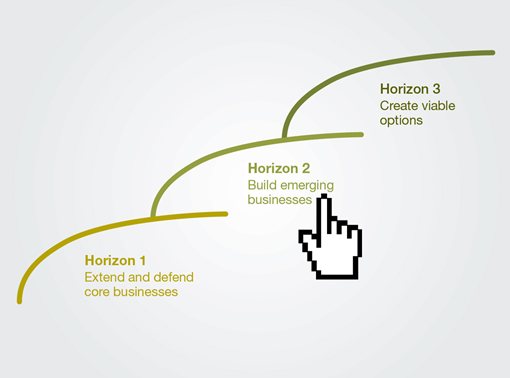3 Horizons and Product Management
A process engineering team came together to explore ways to evaluate the customer support procedures and methods. Their belief was that sloppy process and lack of reporting was increasing their costs while reducing the quality of support. Good news! The team identified a number of procedural changes that would be easy to implement. They also identified some product revisions and new innovations.
Now what?
The problem was the team was working in isolation. They made general recommendations but didn’t have anyone to implement their recommendations.
Some of their results could be put into a report and given to the appropriate department. But changes in product and changes in customer profiles require the involvement of product management and marketing.
Does your organization have a way to move ideas into production?
The three horizons model is a great tool for thinking about product maintenance versus new features development versus new product innovation.
Image source: McKinsey.
The idea is we must consider all three horizons at the same time, developing programs and products for now, the immediate future, and the next big thing
Horizon 1 is our existing core business—the products and services available to our existing customers. We need to keep the products current to meet the needs of existing markets and customers. Obviously, we must maintain those products to keep the company running but these products should be optimized for profit. Some of that profit will fund our next generations of products.
Horizon 2 represents the work we’re doing now for future delivery—the stuff on the roadmap. Revising products for new markets or adding significant functionality to existing products to make them more attractive to new markets. Horizon 2 is optimized for revenue and market share.
Horizon 3 is where most innovation is focused. It’s the work we’re doing with new technology for existing markets or entirely new products for new markets. Horizon 3 is optimized for learning. Before we can scale a new kind of products, we need to learn how to work in the environment. Learning how to create apps or deliver services via video or storage in the cloud.
Much of today’s dialog about innovation, especially Lean Startup, is about Horizon 3. Building new technology, leaning how to deliver it, adapting it to the bellwether customers.
Now what?
The startup or innovation team needs to flesh out the Horizon 3 concepts and move those recommendations to a delivery team. Obviously, we’d want product management on the innovation team but Horizon 2 is where product management really shines. Product management turns ideas into businesses. We need a business plan or canvas to express the market and business goals, the market problems and the product capabilities, and how we’ll get the product to customers.
As my friend Saeed Khan writes, you have to nail it before you scale it .
Ideas are great but the outcome of an innovation meeting needs to be more than a report or presentation. We need to have a product management team take the idea to the next level. We need to turn innovations into businesses.


